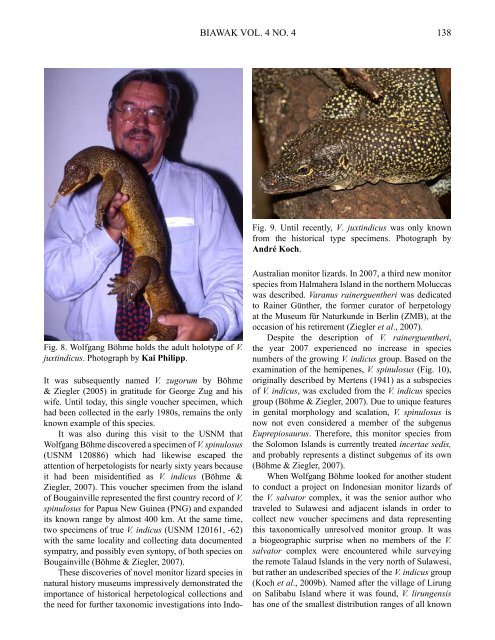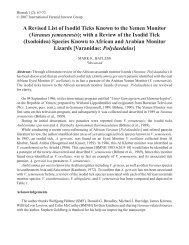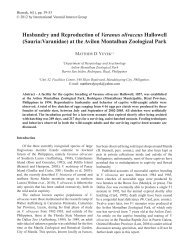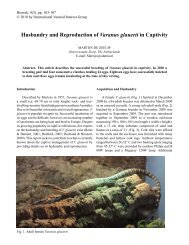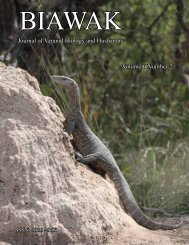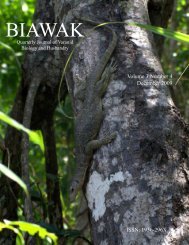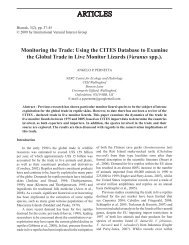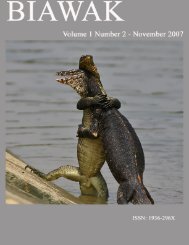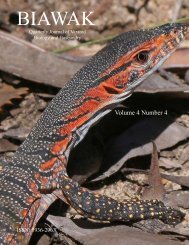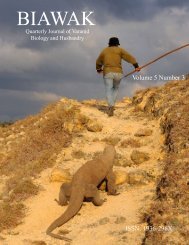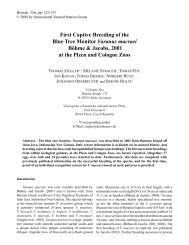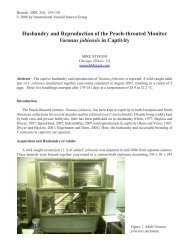BIAWAK - International Varanid Interest Group
BIAWAK - International Varanid Interest Group
BIAWAK - International Varanid Interest Group
- No tags were found...
You also want an ePaper? Increase the reach of your titles
YUMPU automatically turns print PDFs into web optimized ePapers that Google loves.
<strong>BIAWAK</strong> VOL. 4 NO. 4<br />
138<br />
Fig. 9. Until recently, V. juxtindicus was only known<br />
from the historical type specimens. Photograph by<br />
André Koch.<br />
Fig. 8. Wolfgang Böhme holds the adult holotype of V.<br />
juxtindicus. Photograph by Kai Philipp.<br />
It was subsequently named V. zugorum by Böhme<br />
& Ziegler (2005) in gratitude for George Zug and his<br />
wife. Until today, this single voucher specimen, which<br />
had been collected in the early 1980s, remains the only<br />
known example of this species.<br />
It was also during this visit to the USNM that<br />
Wolfgang Böhme discovered a specimen of V. spinulosus<br />
(USNM 120886) which had likewise escaped the<br />
attention of herpetologists for nearly sixty years because<br />
it had been misidentified as V. indicus (Böhme &<br />
Ziegler, 2007). This voucher specimen from the island<br />
of Bougainville represented the first country record of V.<br />
spinulosus for Papua New Guinea (PNG) and expanded<br />
its known range by almost 400 km. At the same time,<br />
two specimens of true V. indicus (USNM 120161, -62)<br />
with the same locality and collecting data documented<br />
sympatry, and possibly even syntopy, of both species on<br />
Bougainville (Böhme & Ziegler, 2007).<br />
These discoveries of novel monitor lizard species in<br />
natural history museums impressively demonstrated the<br />
importance of historical herpetological collections and<br />
the need for further taxonomic investigations into Indo-<br />
Australian monitor lizards. In 2007, a third new monitor<br />
species from Halmahera Island in the northern Moluccas<br />
was described. Varanus rainerguentheri was dedicated<br />
to Rainer Günther, the former curator of herpetology<br />
at the Museum für Naturkunde in Berlin (ZMB), at the<br />
occasion of his retirement (Ziegler et al., 2007).<br />
Despite the description of V. rainerguentheri,<br />
the year 2007 experienced no increase in species<br />
numbers of the growing V. indicus group. Based on the<br />
examination of the hemipenes, V. spinulosus (Fig. 10),<br />
originally described by Mertens (1941) as a subspecies<br />
of V. indicus, was excluded from the V. indicus species<br />
group (Böhme & Ziegler, 2007). Due to unique features<br />
in genital morphology and scalation, V. spinulosus is<br />
now not even considered a member of the subgenus<br />
Euprepiosaurus. Therefore, this monitor species from<br />
the Solomon Islands is currently treated incertae sedis,<br />
and probably represents a distinct subgenus of its own<br />
(Böhme & Ziegler, 2007).<br />
When Wolfgang Böhme looked for another student<br />
to conduct a project on Indonesian monitor lizards of<br />
the V. salvator complex, it was the senior author who<br />
traveled to Sulawesi and adjacent islands in order to<br />
collect new voucher specimens and data representing<br />
this taxonomically unresolved monitor group. It was<br />
a biogeographic surprise when no members of the V.<br />
salvator complex were encountered while surveying<br />
the remote Talaud Islands in the very north of Sulawesi,<br />
but rather an undescribed species of the V. indicus group<br />
(Koch et al., 2009b). Named after the village of Lirung<br />
on Salibabu Island where it was found, V. lirungensis<br />
has one of the smallest distribution ranges of all known


